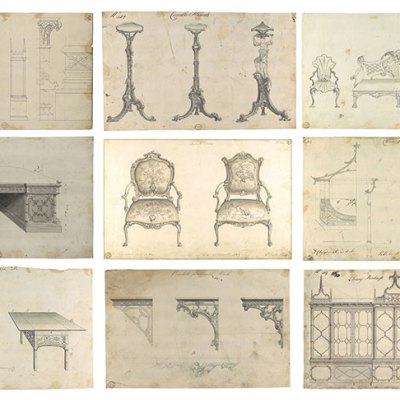Nicholas Goodison will be remembered for a distinguished career in the City, most notably for undertaking those major reforms to the London Stock Exchange that were colloquially known as ‘Big Bang’. But he was also a passionate supporter of the arts, for which he had a deep appreciation. Among many other positions, he served as vice-chairman of English National Opera (1980–98) and as chairman of the National Art Collections Fund, now Art Fund (1986–2002).
To readers of Apollo, however, Nicholas will perhaps best be remembered for his equally illustrious contributions as a scholar of 18th-century decorative arts. His output and the depth of his research in this field were remarkable by any standards.
Writing in Furniture History: Forty Years On (2004), Nicholas recalled how, while at Nostell Priory, West Yorkshire, to look at Chippendale’s ‘extraordinary’ barometer case, he met Lord St Oswald’s archivist, Major Tom Ingram, who in 1966 proposed him for the council of the Furniture History Society, established two years earlier. He recounted the story to illustrate Ingram’s ‘knack for encouraging the young’ – a knack that he certainly possessed himself. Nicholas took a thoughtful interest in young scholars and curators (and even dealers), but clearly had firm ideas about the definition of ‘young’. At a council meeting of the society during the mid 1990s, in his then role as its president, Nicholas spoke of his pleasure at seeing so many younger people entering the field. The furniture historian Lucy Wood and I beamed, only to be deflated when he specified ‘those under 30’. I still smile about this, and recall with pleasure how everyone in the field, regardless of age, continued to benefit from his leadership and quiet wisdom, always so generously given.
Goodison’s report for HM Treasury in 2004, Securing the Best for our Museums: Private Giving and Government Support, was widely praised. It analysed the benefits to be gained from supporting regional and national museums and galleries in acquiring works of art. The Museums and Cultural Property Unit, part of Arts Council England, came into being as a direct result of the ‘Goodison Report’, which recommended that a one-stop shop be established to administer all statutory cultural property functions and to be a free source of impartial advice and guidance to owners and museums. It was also as a result of his recommendation that the Cultural Gifts Scheme was introduced. Anastasia Tennant, who now oversees the unit, perfectly sums up Nicholas’s contribution and passing: ‘without him we wouldn’t exist – end of an era’; her predecessor Gerry McQuillan remembers him as quite simply ‘a good and generous man’.
If there was ever an issue where government needed to be cajoled rather than cornered, there was no one better to consult over how to make the approach. Not one for noisy outrage, Nicholas would invariably favour the quiet word. Although the outcome was ultimately unsatisfactory, I was grateful for Nicholas’s sage suggestions on how to persuade parliamentarians to make the Ivory Act (2018) fit for purpose. He was, throughout the campaign, an encouraging and realistic éminence grise.
Sometime in 2002 Nicholas dropped by and, over green tea (of which he was fond), asked if I would take over as treasurer of the Furniture History Society. I muttered something about not quite feeling up to the role. Well, you run a business, he said, so I am confident you can read a balance sheet. Notwithstanding, I felt trepidation every time I had to present the society’s accounts, but Nicholas never made me feel anything other than comfortable in the role. The society remained solvent.
Last year the Furniture History Society published a long-overdue Festschrift in Nicholas Goodison’s honour, with contributions from many authors who had benefitted from an association and friendship with the volume’s dedicatee. The bibliography of his contributions ran to 11 pages and included his seminal volumes English Barometers 1680–1860: a History of Domestic Barometers and Their Makers (1968) and Ormolu: Work of Matthew Boulton (1974). The list contained further standalone publications, as well as articles, government reports, reviews, obituaries, forewords and more. His contributions to our understanding of English 18th-century design and manufacture were outstanding.
Nicholas and Judith, his wife, were passionate supporters of contemporary craft. Together they continued to make generous gifts to the Fitzwilliam Museum, Cambridge, where Nicholas was honorary keeper of furniture. The catalogue of these donations, Contemporary British Crafts – The Goodison Gift to the Fitzwilliam Museum (2016), includes works by glass makers such as Colin Read, Keiko Mukaide and Bruno Romanelli, ceramics by Edmund de Waal and Kate Malone, metalwork by Junko Mori and Adi Toch and, of course furniture by Alan Peters, from whom Goodison had commissioned furniture for the offices of TSB, which he chaired from 1988–95. A shared love of contemporary ceramics, glass and metalware would mean that my wife Patricia and I sometimes compared notes with Nicholas and Judith at art fairs, having invariably been ensnared by treasures presented by the dealer Adrian Sassoon.
I am not sure how often Nicholas’s business career directly intersected with his reputation as a scholar, but I was reminded last week of an occasion when, in his role as chairman of the London Stock Exchange, he addressed an audience at the Federal Reserve Bank of San Francisco. During the Q&A session, a distinguished economist (and passionate collector) rose to his feet and asked, straight faced, how fluctuations in the price of gold might impact on the market for Matthew Boulton. Quickly recovering his composure, Nicholas introduced Boulton to the bemused audience, and moved on.
Nicholas Goodison was a towering figure, both in the City and in the arts. His warmth and wisdom will be much missed by all who knew him, but most of all by Judith, his wife of more than 50 years, and their family.
Martin Levy is chairman of H. Blairman and Sons Ltd. He was treasurer of the Furniture History Society from 2002–13.



